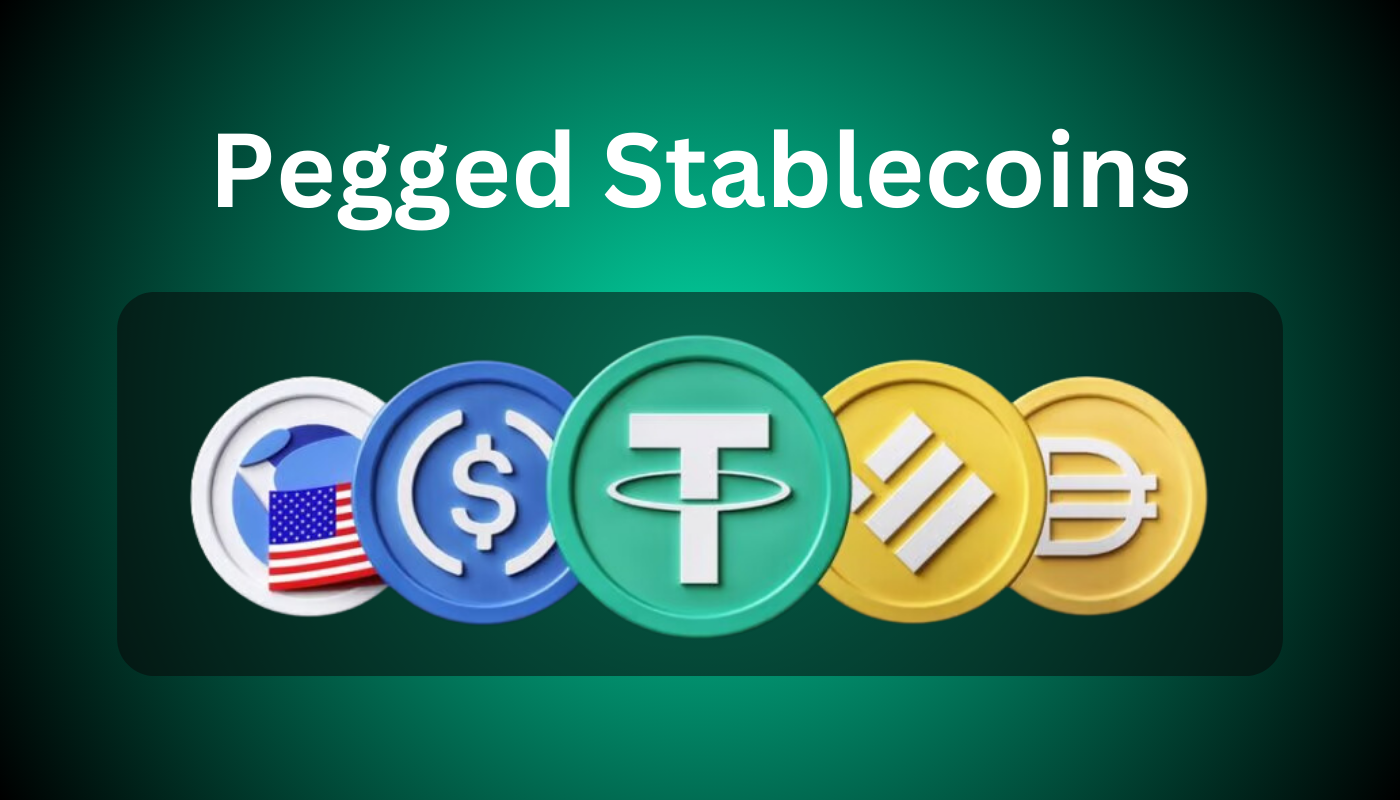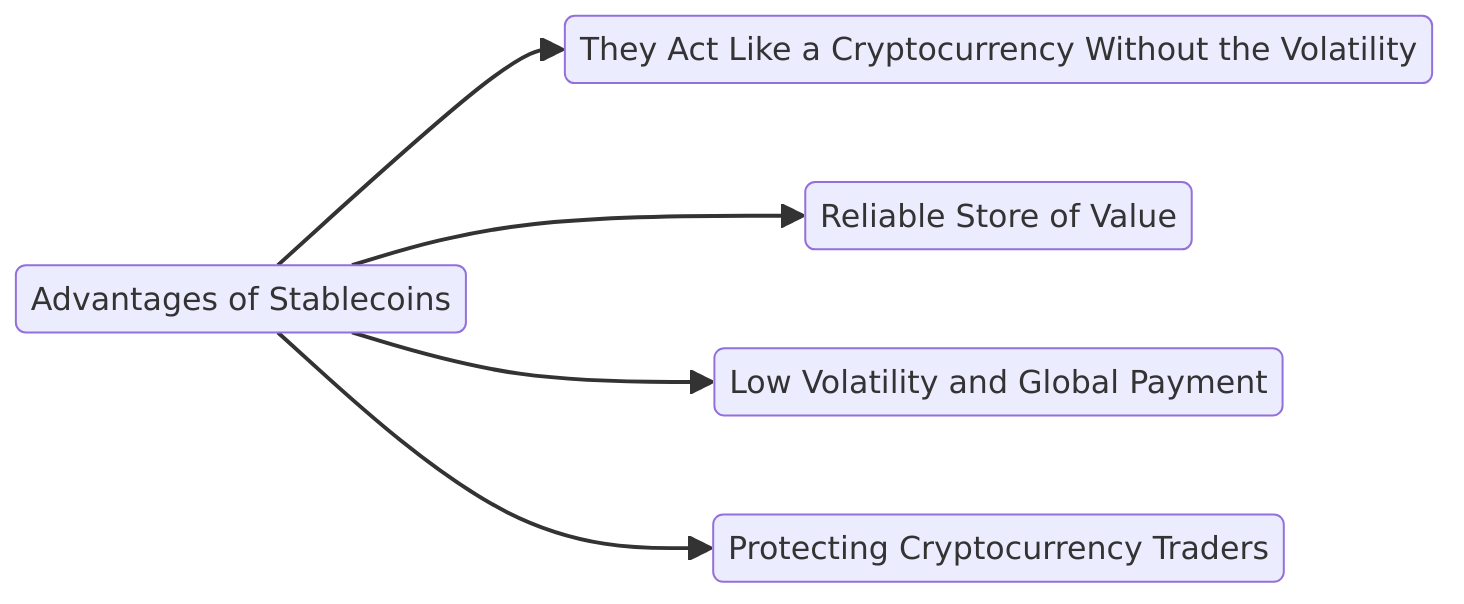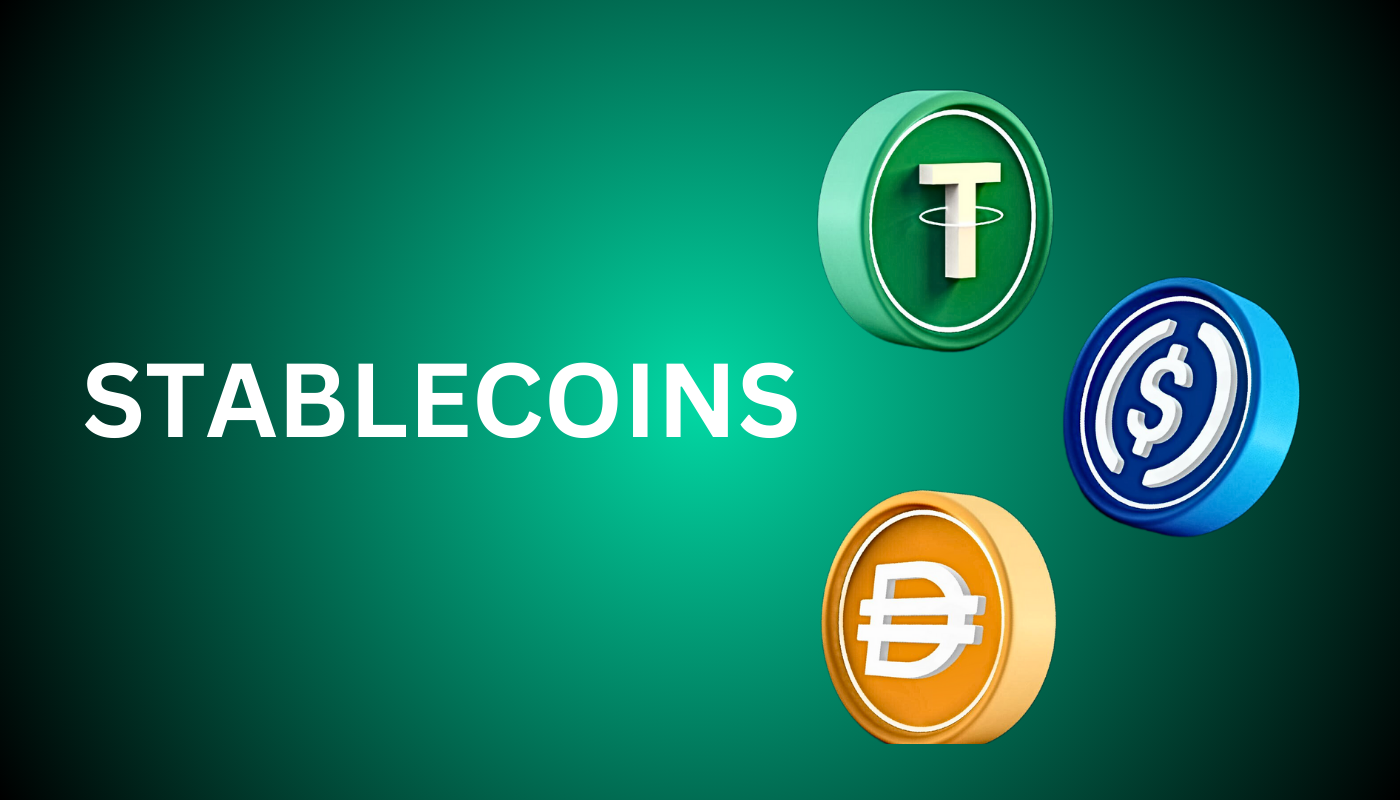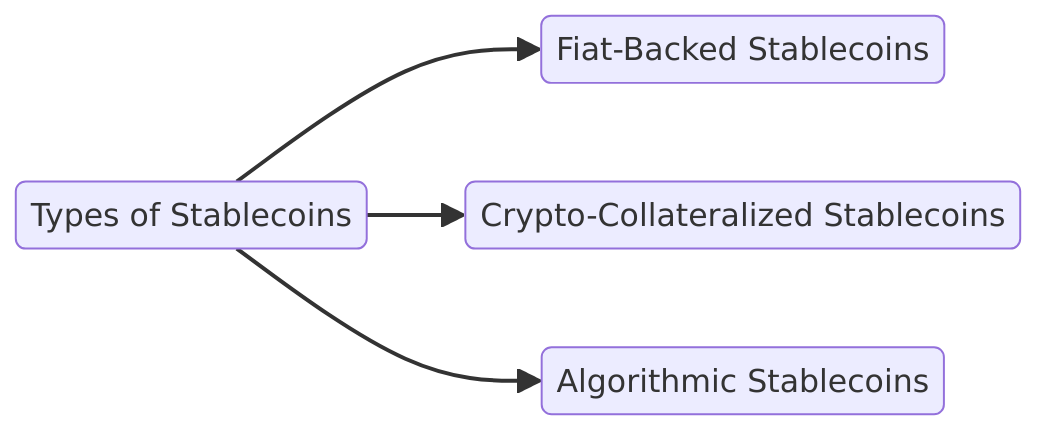What are Pegged Stablecoins?
One type of stablecoin may not be available and usable in a particular blockchain, so that there is a need to create a different stablecoin that suits that particular platform.

Exchanges like Binance have created their own stablecoin, Binance USD (BUSD), for faster and easier transactions in the Binance ecosystem.
Stablecoins are cryptocurrencies pegged to stable assets, typically fiat currencies like the US Dollar, to eliminate the price volatility common in other cryptocurrencies. Popular stablecoins include Tether (USDT), USD Coin (USDC), Binance USD (BUSD), Dai (DAI), TerraUSD (UST), and TrueUSD (TUSD)—all maintaining a 1:1 peg with the USD.
These digital assets are versatile, serving as a store of value and a medium for seamless transitions between traditional fiat and cryptocurrencies.
Utility of Stablecoins
Stablecoins act as utility tokens, simplifying the transfer of value between cryptocurrencies during trades. Their availability across multiple blockchains addresses the diversity of blockchain ecosystems, where certain platforms may require unique stablecoins for compatibility.
For instance, Binance USD (BUSD) facilitates efficient transactions within the Binance ecosystem, ensuring faster and smoother trades tailored to its network. This adaptability underscores the essential role of stablecoins in bridging the gap between real-world fiat currencies and the dynamic world of cryptocurrency.
Introduction to Stablecoins
Stablecoins are a type of digital currency designed to provide price stability and low volatility, making them a preferred choice for users seeking to reduce risk while leveraging the benefits of blockchain technology. These digital assets bridge the gap between traditional financial systems and the cryptocurrency world, offering utility for payments, trading, and investing.
Definition and Brief History
A stablecoin is a cryptocurrency that maintains a fixed value by being pegged to a stable asset, such as fiat currencies like the US Dollar or commodities like gold. The first stablecoin, Tether (USDT), was introduced in 2014, marking the inception of a rapidly expanding market.
Since then, the stablecoin ecosystem has flourished, with various projects catering to different blockchain platforms and use cases. Stablecoins provide a reliable store of value and a medium of exchange, minimizing the volatility that often deters traditional cryptocurrencies’ adoption.
Their consistent value and adaptability make them indispensable tools for traders, investors, and global payment systems.
Advantages of Stablecoins

1. They Act Like a Cryptocurrency Without the Volatility
Stablecoins combine the decentralized and anonymous nature of cryptocurrencies with price stability. Unlike volatile cryptocurrencies like Bitcoin or Ethereum, stablecoins maintain their value by being pegged to fiat currencies such as the US Dollar (1:1 ratio) or commodities like gold.
- For example: Sending 1,000 USDC from one wallet to another is as seamless as transferring Ethereum but without worrying about value fluctuations.
- Fact: Over $1 trillion worth of transactions occurred using stablecoins in 2023, highlighting their growing adoption as a trusted payment method.
Stablecoins also allow users to transact freely, without reliance on banks or the scrutiny of centralized authorities, ensuring financial privacy and independence.
2. Reliable Store of Value
Stablecoins are an excellent hedge against the volatility of traditional cryptocurrencies. Unlike Bitcoin, which can lose or gain over 30% of its value in a single month, stablecoins remain unaffected by market swings.
- For example: During the 2022 crypto bear market, traders moved assets into stablecoins like Tether (USDT) and USD Coin (USDC), protecting their portfolios from losses as Bitcoin dropped from $68,000 to $16,000 in less than a year.
- Data: As of 2024, 72% of cryptocurrency traders use stablecoins to hedge against market downturns.
This stability ensures your capital is preserved during bearish markets, providing a reliable alternative to high-volatility assets.
3. Low Volatility and Global Payment
Stablecoins enable seamless global payments, eliminating the complications of cross-border banking systems. Since they are pegged to stable assets, their value doesn’t fluctuate dramatically.
- Advantage: With stablecoins, international transfers are processed in minutes, often costing less than $1 in fees, compared to traditional cross-border payments that take days and charge high fees.
- Real-World Use: Platforms like Binance Pay and Crypto.com allow merchants worldwide to accept payments in stablecoins, broadening financial inclusion.
4. Protecting Cryptocurrency Traders
Stablecoins act as a safe haven for traders during volatile market periods.
- Benefit: Traders can quickly convert volatile assets like Bitcoin into stablecoins to avoid losses. For example, converting 1 BTC ($30,000) into 30,000 USDT ensures your portfolio value doesn’t drop if Bitcoin crashes.
- Additional Use Case: Stablecoins are commonly used as collateral for crypto-backed loans. For instance, depositing 5,000 USDT as collateral can secure a loan in another cryptocurrency without having to sell your holdings.
This flexibility provides liquidity while maintaining market exposure, making stablecoins indispensable for managing risks and capital in the cryptocurrency ecosystem.

Types of Stablecoins
1. Fiat-Backed Stablecoins
Fiat-backed stablecoins are collateralized by traditional assets like fiat currencies (e.g., USD, EUR) or precious metals (e.g., gold, silver). Each stablecoin is typically pegged to its collateral on a 1:1 ratio.
- Example: Tether (USDT) claims to maintain reserves equal to the total USDT supply in circulation.
- Fact: USDT and USDC are the most widely used fiat-backed stablecoins, with a combined market cap exceeding $100 billion as of 2024.
- Transparency: These stablecoins are often audited by third-party firms to ensure reserves match the tokens issued.
2. Crypto-Collateralized Stablecoins
These stablecoins are backed by digital assets like Bitcoin (BTC) or Ethereum (ETH) rather than fiat currencies. To mitigate crypto volatility, they are typically over-collateralized.
- Example: To mint $5,000 worth of DAI, you might need to lock up $10,000 in ETH as collateral.
- Risk Management: Even if ETH’s value drops by 40%, the $5,000 worth of DAI remains fully backed.
- Popular Tokens: Dai (DAI) and sUSD are leading examples, widely used in decentralized finance (DeFi) applications.
3. Algorithmic Stablecoins
Algorithmic stablecoins use smart contracts to manage token supply dynamically, increasing or decreasing circulation to maintain a stable value.
- Mechanism: When demand rises, the algorithm mints more tokens to stabilize the price. When demand falls, tokens are burned to reduce supply.
- Example: Ampleforth (AMPL) uses an elastic supply model, adjusting the number of tokens in users’ wallets during rebases.
- Risk: These are considered high-risk since they lack traditional or crypto-backed reserves. The failure of TerraUSD (UST) in 2022 highlighted the vulnerability of algorithmic stablecoins.
Understanding these types of stablecoins can help users choose the right one for their needs, whether for trading, hedging, or payments.

How Pegged Stablecoins Work
Pegged stablecoins are designed to maintain a stable value by linking their worth to a fiat currency (like the US dollar) or a commodity (like gold). Their stability is achieved through mechanisms like collateralization, market operations, and strategic issuance and redemption processes.
1. Collateralization
Collateral serves as the backbone of pegged stablecoins, ensuring that their value remains stable and trustworthy.
- Fiat-Backed Collateral: Stablecoins like USDT and USDC are pegged 1:1 to fiat currencies. For every stablecoin in circulation, an equivalent amount of fiat currency is held in reserve.
- For example: If 1 billion USDC are issued, there should be $1 billion held in reserves, typically stored in bank accounts or short-term treasuries.
- Audits: Reputable issuers undergo regular audits to verify reserves and ensure transparency.
- Crypto-Backed Collateral: Stablecoins like DAI are backed by cryptocurrencies. Users lock up assets such as ETH in smart contracts, creating over-collateralization to account for market volatility.
2. Fiat Currency Trading Pairs
Pegged stablecoins often function as intermediaries between fiat currencies and cryptocurrencies, enabling seamless transactions and hedging against volatility.
- Trading Pairs: On exchanges, pegged stablecoins are used as base trading pairs for assets like Bitcoin (BTC) and Ethereum (ETH).
- For example: A trader can convert BTC to USDT to secure profits during a market downturn and re-enter the market later.
- Global Accessibility: Stablecoins provide a bridge for users in regions with limited access to the USD or global financial systems, enabling efficient and low-cost cross-border transactions.
3. Mechanisms to Maintain the Peg
The stability of pegged stablecoins relies on mechanisms that adjust supply and demand to preserve their value.
- Issuance and Redemption:
- When demand for a stablecoin rises, users can mint new tokens by depositing collateral.
- When demand falls, holders can redeem stablecoins for their underlying assets, reducing the circulating supply.
- Market Operations: Algorithmic mechanisms or issuers actively buy or sell tokens to stabilize prices around the peg.
Common Issues with Stablecoins
While stablecoins have become a vital component of the cryptocurrency ecosystem, they face several challenges that highlight potential risks and limitations for users.
1. Regulatory Concerns for Stablecoin Issuers
The rapid growth and market capitalization of stablecoins have drawn significant attention from regulators and policymakers worldwide.
- Increased Scrutiny: Governments and financial authorities are demanding stricter oversight, including regular audits and compliance frameworks similar to those applied to banks and traditional financial systems.
- Transparency Challenges: The lack of standardized regulations raises concerns about the accountability of stablecoin issuers. For instance, Fiat-backed stablecoins like USDT must prove their reserves to ensure 1:1 collateralization with the U.S. dollar.
- Fiat Dependence: The reliance on fiat currencies, like the U.S. dollar, makes stablecoins susceptible to broader monetary policy changes or geopolitical risks.

2. Stablecoin Collateral Concerns
Collateralization is central to a stablecoin’s integrity, but doubts about reserve management persist.
- Fiat Collateral Risks:
- Tether (USDT) has faced allegations about whether its reserves fully back the circulating supply.
- If these reserves are insufficient, it could undermine market confidence and destabilize the ecosystem.
- Commodity-Backed Stability: Stablecoins backed by tangible assets, such as gold or other commodities, provide an alternative layer of stability. For example, Stablecoins like Paxos Gold (PAXG) are directly linked to physical gold holdings, offering greater transparency.
3. Lack of FDIC Insurance
Stablecoins function as a digital store of value but lack the safety net of traditional banking protections.
- No Insurance Coverage: Unlike savings accounts, stablecoins are not insured by the Federal Deposit Insurance Corporation (FDIC) or equivalent entities.
- Risk Scenario: If an issuer like USDT or BUSD were to collapse, users could lose their holdings entirely.
- Comparative Safety: Bank deposits are insured for up to $250,000 in the U.S., offering significant protection against institutional failures. Stablecoins, however, operate without such guarantees, exposing users to higher risks.
Conclusion
Stablecoins provide significant benefits, but regulatory concerns, collateralization transparency, and the absence of insurance protections are key challenges that require attention. Addressing these issues is crucial to fostering greater trust and widespread adoption of stablecoins in the global financial ecosystem.

FAQs About Stablecoins
1. What are stablecoins, and how do they work?
Stablecoins are cryptocurrencies designed to maintain a stable value by being pegged to a fiat currency (like the US Dollar) or a commodity (like gold).
- Mechanism: They achieve stability through collateralization (fiat or crypto reserves) or algorithmic adjustments of supply and demand.
- Example: Tether (USDT) is backed by USD reserves, maintaining a 1:1 peg with the U.S. dollar.
2. What are the main types of stablecoins?
There are three primary types of stablecoins:
- Fiat-Backed Stablecoins: Collateralized with fiat currencies like USD. Example: USD Coin (USDC).
- Crypto-Backed Stablecoins: Collateralized with cryptocurrencies, often over-collateralized to manage volatility. Example: Dai (DAI).
- Algorithmic Stablecoins: Maintain stability using smart contracts to adjust supply without collateral. Example: Ampleforth (AMPL).
3. Why are stablecoins important in the cryptocurrency ecosystem?
Stablecoins play a critical role in:
- Facilitating Transactions: Enable seamless and low-cost transfers between cryptocurrencies and fiat currencies.
- Hedging Against Volatility: Provide a safe haven during market downturns, preserving value for traders.
- Global Payments: Simplify cross-border transactions without intermediaries, reducing fees and delays.
4. Are stablecoins safe to use?
Stablecoins are generally safe but come with specific risks:
- Regulatory Concerns: Lack of standardized regulations can affect their transparency and reliability.
- Collateral Risks: Questions about reserves backing fiat-collateralized stablecoins (e.g., Tether).
- No FDIC Insurance: Unlike bank accounts, stablecoins are not insured, posing a risk if issuers collapse.
5. How do stablecoins compare to traditional cryptocurrencies?
Stablecoins differ from traditional cryptocurrencies like Bitcoin (BTC) in several ways:
- Stability: Stablecoins maintain a consistent value, while traditional cryptocurrencies are highly volatile.
- Use Cases: Stablecoins are ideal for payments, trading, and hedging, whereas traditional cryptocurrencies are often used as speculative investments or stores of value.
- Adoption: Stablecoins are widely used in decentralized finance (DeFi) and global payment systems due to their reliability.
Sidebar rates
HFM
wgt-lc-defi
- DeFi Lending
- DeFi Yield Farming
- AMM (Automated Market Maker)
- DEX
- Cross Chain Bridges
- Crypto Options
- Tokenized Bonds
- Crypto Derivatives
- On-chain synthetic Assets
- Cryptocurrency Perpetuals
- Cryptocurrency Staking
- Cryptocurrency Total Locked Value (TVL)
- Impermanent loss
- Rebase Token
- Decentralized Autonomous Organization
- Decentralized Application
- Gas Fees
- Liquidity Pools
- Cryptocurrency Tokenomics
- Pegged Stablecoins